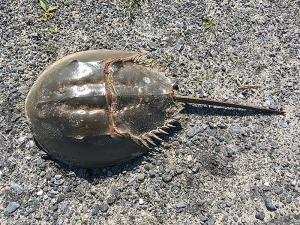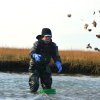Talking about horseshoe crabs and Big Stone Beach
You have to go north of Broadkill to find the best spots in the brackish water of the Delaware Bay for horseshoe crabs to breed. Accordingly, we’ve driven 30 miles past Milford to Big Stone Beach to walk with Kate Fleming, a coastal ecologist with Delaware Sea Grant, whose principal job is to keep tabs on the spawning horseshoe crab population.
Kate embodies my personal theory that there’s been a generational divide in America as stark as the different strata in a sedimentary rock outcropping.
Those under 40, having come of age with their personal futures threatened by the planet’s environmental collapse, are different in fundamental ways from those of us over 40 who, if not in denial, take secret comfort that we’ll be dead and gone when things get really bad.
Her career track illustrates my point: College at George Washington University intending to pursue international relations. Which led to global public health. Which led to a specialty in ‘anthropogenics,’ or human-caused disturbances. Which led to a once-in-a-lifetime experience doing shipboard research tagging striped bass and Atlantic salmon. Which led to her current career in ecology and choice to work in low-lying Delaware because it’s on the front lines of climate change (worst-case estimates project loss of 11 percent of the state to rising seas by 2100).
A few words about Big Stone Beach, once one man’s private holding until it was deeded to the state. For starters, the ‘big stones’ are in fact not stones (which accounts for the absence of such formations elsewhere on the bay). Rather, they are the accumulated secretions from eons of worms which use their self-made mounds for shelter. Another one of nature’s wonders.
Horseshoe crabs (the name’s a misnomer; they’re actually invertebrate arthropods akin to spiders) have been around in their present form for 3 million years, give or take.
Which means they long ago conclusively solved the evolutionary riddle of their niche. That is, until people discovered a use for their blood and began reducing their numbers.
Simply put, the crabs immunize bacteria by secreting particles in their blood that clot into a white goo. The pharmaceutical and medical instrument industries test the purity of their products using droplets of the blood – no goo, no germs.
Which has led to commercial harvesting.
There are official quotas, in principle, but with a price on their heads, the horseshoe crabs’ sustainability is increasingly problematic. And, in the ecological chain, that poses threats to long-distance migrating birds that depend on their super protein-rich eggs to fuel journeys that can stretch from Patagonia to the Arctic tundra.
Hence the annual count to monitor populations during the full moons of May and June.
Those are the nights when females, which have migrated to shallow coastal waters, crawl onto the mud where they’ll lay 20 egg clusters during a single spawning season, with about 4,000 eggs per cluster.
They’re followed by crews of smaller males, with front claws specifically designed for the purpose, struggling to climb atop them and be the alpha who spreads his seed. Kate’s specific task, with the help of citizen scientist volunteers, is to document the ratio of males to females.
The Delaware Bay is a global hot spot for this veritable orgy (breeding in captivity hasn’t worked; mating occurs only on the same sand where the eggs hatched).
Crabs trapped on the beach, too exhausted to return to the water, desiccate the next day in the sun. If you want to throw one back, don’t pick it up by the fragile tail, which easily breaks off, because that’s what the crab uses to navigate.
Kate stops to examine the wrack line, the edges of residue in the sand left by upwashing tide, the detritus most of us ignore.
“A groomed beach is good for sunbathing, but that destroys the wrack, and the wrack is where the food chain starts,” she said. “Washed-up grasses provide shade that traps moisture; beetles and arthropods feed off the organic material, and they make the prey base for migratory sea birds.”
She spots the shell of a mantis shrimp, a rare find on this beach. They’re thought to have the most complex visual systems ever discovered (humans have three types of photoreceptors, while mantis shrimp have more than a dozen). “Their eyes are crazy; they see colors nobody else sees.”
As we’re leaving, Kate explains that she loves this place because, without a community of houses behind it, there’s little human intrusion. “I get to appreciate its importance for habitat resilience. It’s a window into natural processes that we don’t often get to see or appreciate.”






















































